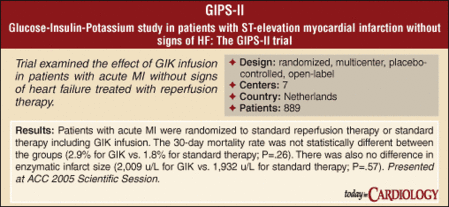Limited benefit with GIK as adjunct to reperfusion in acute MI
ORLANDO — The use of a glucose/insulin/potassium infusion to treat patients with acute myocardial infarction did not reduce mortality after 30 days according to the results of a late-breaking clinical trial presented here.
“Glucose/insulin/potassium (GIK) infusion as currently used does neither reduce 30-day mortality nor enzymatic infarct size in patients with ST-elevation MI without signs of heart failure treated with reperfusion therapy,” Jorik Timmer, MD, said while presenting the results. Timmer is at Isala Klinieken in The Netherlands.
GIPS-I and GIPS-II
The Glucose-Insulin-Potassium Study (GIPS-II) in patients with ST-elevation MI without signs of heart failure was aimed at confirming the results of GIPS-I: an earlier trial that also examined the effect of GIK infusion in patients with acute MI.
GIPS-I demonstrated improvements to 30-day mortality in patients who showed no signs of heart failure; the difference in patients with AMI was not significant.
The trial was a randomized, multicenter, open-label trial of 889 patients with symptoms of acute MI or ST-elevation. Twenty-seven percent of patients were women, 94% were undergoing primary percutaneous coronary intervention and almost all received reperfusion therapy.

Patients were treated with standard reperfusion therapy or with a GIK infusion in addition to standard therapy within 12 hours of admission to the hospital.
The infusion consisted of 20% glucose and 80 mmol potassium at a fixed rate of 2 ml/kg body weight per hour and the duration of infusion was 12 hours.
Insulin was also infused according to glucose levels, with in general a starting dose of five units per hour.
Effects of GIK
The 30-day mortality rate between the control group (1.8%) and those receiving GIK (2.9%) was not statistically significant (P=.26). Anterior infarction occurred more often in the GIK group compared to the control group (48% vs. 39%; P=.01).
An assessment of peak CK levels showed that the difference in enzymatic infarct size between the GIK group and the control group was also not significant (2,009 u/L vs. 1,932 u/L; P=.57). Overall, there were no major differences in mortality between the GIK group and control group.
In a press release, Timmer said: “GIK infusion may be beneficial in some specific patient groups, but the benefit of GIK infusion when given as an adjunct to reperfusion in patients with acute MI but no signs of heart failure is probably limited or absent.” – by Nancie Brown
For more information:
- Timmer J on behalf of the GIPS-II investigators. Glucose-Insulin-Potassium study in patients with ST-elevation myocardial infarction without signs of heart failure: The GIPS-II trial. Late-breaking trial presented at the American College of Cardiology Annual Scientific Session 2005. March 6-9, 2005. Orlando.
